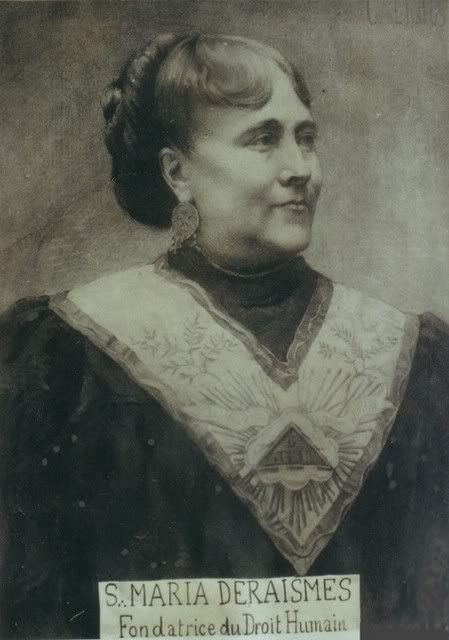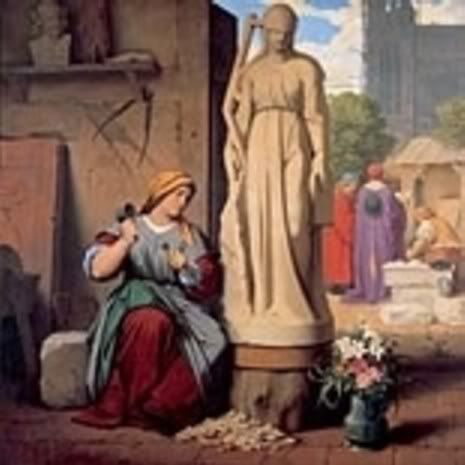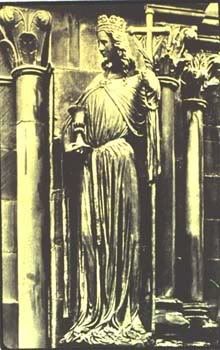Post by Tamrin on May 24, 2009 19:21:12 GMT 10
A Brother has kindly emailed a link to a Le Droit Humain site, in French, on which are listed several short biographies. I have run those of the women through AltaVista’s Babel Fish translation, with the following results (I have not presumed to correct even obvious errors in the translations for fear of adding error to error and I expect my efforts would be no better than that of the readers’).But first, a photograph of Maria Deraismes.

Blanche Mesnage (1870 - 1942)
Girl of a naval officer died prematurely, Blanche Mesnage lived with her mother and her four sisters under difficult conditions. She prepares only her baccalaureat whereas she is controlling in easy families. She becomes the secretary of Eugene Brieux, an author of plays to social topics. She continues her studies and becomes professor of letters.
She is initiated in 1914 and collaborates with Eugene Piron. She will ensure the secretariat of the Supreme Council Sa correspondence written in a clear style and without set language a mine of information brings on the cabins of the Human Right under the Great Control of Eugene Piron. Blanche Mesnage lived in a very modest way in a very small room to the war of 1939 - 1945. Very weakened it was allowed in an old people's home in 1942, year when it dies suddenly.
Clemence Royer (August 31, 1830 - February 6, 1902)
It is born on August 31, 1830 in Nantes in a family from royalists legitimists which supports the duchess of Berry. She knows until 1840 a life wandering with her parents. On this date the family settles in Mans where Clémence is sent in a convent to make her studies there. She is then attracted by mysticism. The family returns to Paris in 1843. It is in this city that it will live the Revolution of 1848, to move away definitively from the religion and to become republican.
The death of his/her father in 1849 obliges it to earn its living. It initially becomes controlling children in England then in a castle of Touraine where it will devour the books in particular the philosophers of the Lights. In 1860 it leaves to settle in Switzerland in a farm located close to Lausanne. It finds the place where it already lived with her parents. It carries out a poor life of country-woman but it is quickly known thanks to the courses of logic which it gives to the women of Lausanne. Its ideas frighten in particular when she says that the man is an animal. It then continues its courses in other cities.
In Lausanne she knew an economist Pascal Duprat with whom she attends in 1863 with the International Congress of social Sciences Ghent. The same year it takes part in a contest organized by the canton of Vaud and draft of "the tax or the social dîme" It shares the first price with Proudhon. It marries Pascal Duprat of which it has a Rene son.
Its fame extends. It writes and publishes. The death of her husband in 1885 leaves it stripped and without resources. It has a miserable life then. It will have using Mrs. Léopold Lacour to be allowed in an old people's home where it dies on February 6, 1902. His/her son dies on November 11 of the same year in Tonkin.
The work of Clemence Royer is of a great richness. Scientist recognized it translated in 1862 the work of Darwin but its research was well beyond that. From 1859 it worked out the theory of the formed cosmic substance of fluid atomic elements. It supplemented with work on prehistory.
The essence of those relates to the man. It makes work of sociologist but it is the condition of the women which interests it more. It shows clearly the injustice and the inequality of its condition, takes part in the feminist movement where it meets Maria Deraismes, Marie Bonnevial. Moved away from any religion it affirms the judgment of the dogmas. Its religion, says it, is the Truth. It is one of the founder members of the Human Right in 1893. It is Vénérable of honor of the mixed cabin. Admittedly it is old and moves with difficulty. Also Albert Lantoine wondered about his presence with the meetings. The question is elsewhere. Frederic Desmons, in the name of the GODF, known as of it the day of its funerals "Which more than Clémence Royer were worthy to belong to the Frank Masonry?" The celebration of its centenary in 1930 put in obviousness quality and the size, and of its personality and its work
ÉLISE ROUET (1918 - 1998)
It is born in Pau on July 1, 1918 in a modest family. It is in this same city that it dies on November 7, 1998.
She initially was a teacher of the public school but quickly directed herself towards the public office with the Prefecture of Pau where she will direct after the second world war the service of ex-serviceman.
When this war bursts, Elise Pujo has just been 21 years old. She already is very attached to the republican values, also she engages quickly in the voice of freedom by making the choice fight in the shade. She will be a great figure of Resistance in her area. A testimony of a mason of the Human Right is to be quoted: She worked within a network whose chief of its sector was called "Paloma". She helped of the Jews and other people sought by Gestapo to pass the Spanish border.
She saved Jewish children of Polish extraction. Its action was recognized. His courage, his control was greeted. It received a certain number of decorations: Commander of the National order of merit, Officer of the Legion of Honour, Military Cross 39/45, Medal of Resistance, Cross of the Polish Merit with sword.
After 1945, it engages actively in various social works and in particular in associations of ex-serviceman. It shown a real devotion there, knowing at the same time to make comply with the rules and to be with the listening of the others.
Elects was attracted by the ideal maconnic. It is initiated in 1955 in a cabin of the Large French Female Cabin. It leaves this obedience and joined the Human Right on December 18, 1960. It attaches a great importance to the humanistic ideal and the initiatory step of the frank-maçonnerie. Within obedience it climbed the various degrees to reach the 33° and last degree of the Order. It occupied various functions, since that of Worthy of the Cabin of Pau until that of President of the National Council in 1981 and of Very Powerful Large Commander of the French Federation of 1990 to 1997. It was member of the Supreme Council. Qualities that it had shown in the world profane were the same ones which animated its action with the Human Right.
It combined a force of character to a human hot summer days. It could be rigorous in its work, it sought to make reign justice and the equality in the compliance with the maconnic rules. Those which were likely to work at its sides, have the memory "of a Large Injury".
Louise Koppe
Born in 1846, altruistic Louise Koppe, free thinker, woman of action were an untiring worker. She died at the 51 years age after a life of devotion. She had founded in the 1891 "Maternal House" of Belleville. She accomodated children there belonging to families struck by unemployment or the disease. Lodged, nourished, vêtus, they were returned to their parents when the material situation of the latter had improved. She had the joy before dying to see the State paying homage to her work by recognizing "the Maternal House" like works of public utility. During all its life Louise Koppe applied the ideal which animated it, it which wished at the time of its entry to the Human Right in 1894, "to raise its heart and its intelligence by directing them towards the Good and to give to any human being the assistance and the assistance which it needs".
Maria Deraismes
Marie Adelaide Deraismes whose Maria is not that the diminutive is a emblematic figure of feminism, it is a woman of before guard. She is cofondatrice of the Human Right with George Martin.
She was born on August 15, 1828 in Paris in a comfortable Parisian hearth and cossu. His/her father, François Deraismes is a liberal and republican middle-class man. He is a police chief in goods. He dies in 1852. His/her mother, Anne Soleil, are the niece heiress of a known optician. She dies in 1861. Marie has a seven year old sister its elder, more known under the name of Anne Féresse. Without child, after his widowhood in 1865, Anne returns to live at Maria.
Maria is a cultivated woman, intellectual accomplished. Its education is higher than that of the girls of the time, her scholarship is large. It studies Latin, the Greek, the philosophers, the Bible, the fathers of the church, the translations of the books of India and the Eastern religions. It practises the theatre, painting and the music. At twelve years, it tries out the art of public speaking and transforms the kiosk of the family garden into platform where it makes speeches. In its youth, it is pilot revolution of 1848 and coup d'etat of 1851. It lived the history of the Second Empire, the latent opposition of a intellectual elite, the collapse of the Empire and the birth of the III° République. By personal choice, Maria, remains unmarried.
Maria and her Anne sister have an intense intellectual life and, into their living room flows the liberal republic. Quickly, Maria becomes the spokesman of the combat of the female emancipation. She animates "the Company for the claim of the women" which fights for the development of female teaching. She collaborates in a regular way in various newspapers: The Large Newspaper -- the Time -- the Pope Joan like with the review Women's right.
Its republican ideas and its reputation of speaker allure the politicians of the time, in particular, those acquired with feminism. Thus since 1866, it is requested by the Great East of France, exclusively male obedience, to take part in conferences. With turn of role, it approaches morals, the history, the literature, the right of the child, the role of the clergy in the company, the woman, etc.
Bronchitides with repetition prohibit to him for a time the platform. During the summer 1870, it leaves food near her uncle close to Saint Malo, it misses thus of Paris during the Commune. One year later, after the disaster of this war, it goes back to Paris and undertakes a campaign in favour of the democracy. It adheres to the Freethinking, it melts a section which it animates, then the newspaper the Freethinking of the Seine and Oise creates. It contributes with the frank-maçon Leon Richer of the Great East of France, with the first international congress of the "Women's right". In June 1881, it triumphs in front of more than four thousand delegated, in the absence of president Victor Schoelcher whom it replaces with the congress anticlerical, during which decisions concerning the separation of the Church and the State are made.
Its activity and its engagement are such, that a Committee is formed to present its candidature for the legislative elections. Woman of reason, it declines the offer, knowing her inadmissible candidature.
January 14, 1882, opens for Maria Deraismes one new period. With the assistance of brothers of the Large Cabin Scottish Symbolic system, it is regularly initiated with the cabin the Free thinkers in Pecq. The transgression of the cabin to the principles was bold, to initiate a woman was not authorized and the brothers had to be solved more to receive it in cabin. In front of the persistence of this rejection, Maria considers of her duty to give up imposing itself in a male cabin. She is reduced to silence maconnic until April 4, 1893, date on which she melts in collaboration with George Martin, the Large Cabin Scottish Symbolic system of France, Human Right called to become the Order Maçonnique Mixte International Human Right.
Maria Deraismes will not see the crowning of her work, as well profane as maconnic. She dies on February 6, 1894; she is buried civilly and rests with the cemetery of Montmartre. This character out of the commun run which fought so that the woman is recognized with whole share deserved well to be honoured. June 16, 1895, a street bearing its name is inaugurated in the prolongation of the public garden of the Virginals in the 17° district of Paris. In this same public garden, July 3, 1898, its covered statue of the cord maconnic is set up; but during the Second World war, this statue is dismounted to be molten with the profits of the occupants. Nothing dies, all is alive, since June 14, 1984 the statue took again its place.
This woman of talent brought much, it fought so that the Man acquires more freedom, to advance the equality of the man and the woman and that one and the other manage to profit in an equal way of social justice in a humanity organized in free and fraternal companies. During many years, Maria fought in the capacity as "mason without apron" will say us, but it opened to all the people of goodwill the way of the mixed frank-maçonnerie and allowed a democratic projection for the women.
Marie Béquet de Vienne
It was born in Paris on February 4, 1854 and it will be founder member of the mixed cabin "the Human Right" created on April 4, 1893. The altruism which animated it, its comprehension of human misery made it be concentrated more particularly on the problem of the maternal assistance. With a will inébranlable, it establishes a complete programme of assistance to the mothers, by creating "the work of the Breast-feeding and the refuges -- sewing rooms for pregnant women". It was thus the true precursor of the law of June 17 1913 which created an obligatory service in favour of the women in labour. Among those which have to him paid homage let us quote: Jules Ferry, Jules Simon, Doctor Roux, President Emile Loubet, President Poincaré. This one thanked it in the name of the Authorities, May 24, 1913. Marie Béquet of Vienna died out a few months later, September 25, 1913. Its foundation strip to function 9 street Jean-Baptist Dumas in Paris (17th).
Marie Bonnevial (June 28 1841- December 4, 1918)
It was born in Rive from Gier in a family from very modest condition. She succeeds in making studies and becomes laic teacher in Lyon under the Second Empire. She very quickly appears very sensitive to the social injustices against which she expresses. At the time of the war of 1870 it becomes voluntary nurse and in 1871 it joined the movement of the Commune. It militates for the creation of a trade union for the teachers. Under the government of the Moral Order it is déchue of its functions because of its support to the Communards and those which were condemned after May 28, 1871. It is exiled in Turkey where one of his/her aunts was already. It is engaged by families of the commercial middle-class. It teaches French with the children. It returns to France in 1877.
It comes then to Paris where it creates, in the 18è district, a vocational school. At this point in time it ties relations with varied mediums: spiritistic, literary. It militates within the League of the women's rights where it meets Maria Deraismes, Clémence Royer.
November 3, 1894 it is initiated within the cabin n°1. In 1895 it creates, in Lyon, the cabin n° 2 today "Evolution and Harmony" and in 1904 it creates the cabin n°4 which bears today its name like titrates distinctive.
Its personality and its activities make known it and impress. It is in liaison with many masons as Gabriel Persigoud in Bordeaux with which it militates for the creation of a trade union for the teachers. During the war it took again its activity of voluntary nurse In 1913 it is a president of the Standing committee of the Supreme Council. With the death of Marie-George Martin it succeeds to him the station of Large Mistress. December 4, 1918 it is reversed by a military ambulance and dies in the hospital.












